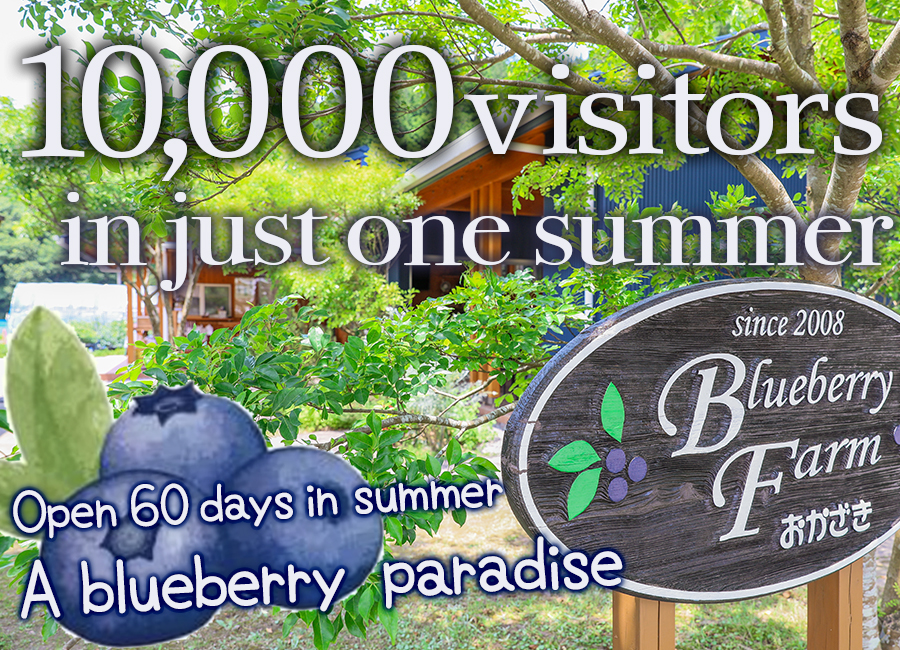
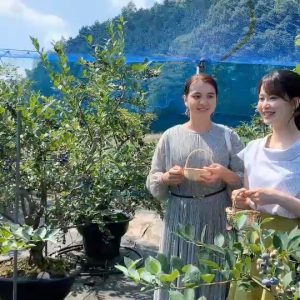

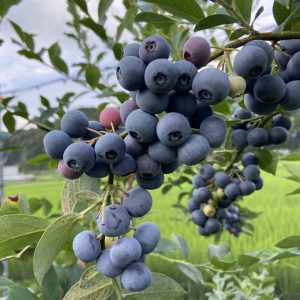
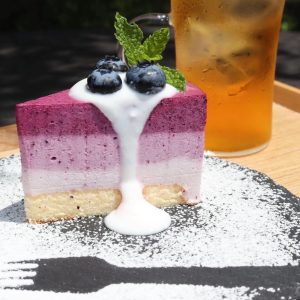
▶A Message from the Farm Owner
2025 Blueberry Picking Season
Season Dates: June 1 – August 17
Reservations open: May 23
Advance reservations required
We warmly welcome visitors from overseas to our farm!

Welcome to Blueberry Farm Okazaki. Open for just 60 days of summer, our farm is a peaceful paradise that provides a unique experience to our visitors.
In just one summer, we had 10,000 visitors, 99% of which agreed that they thoroughly enjoyed our delicious blueberries.
Enjoy the warm breeze on the terrace and tuck into desserts made with freshly picked blueberries straight from the farm. We hope you come visit!
Promotional video lyrics 
10,000 visitors in summer / 30 min drive from Nagoya / Bringing you the finest blueberries / Welcome to Blueberry Farm Okazaki
As gentle rays of light embrace a moment of peace / You fall into nature’s relaxing rhythm / A gentle breeze whistles by your ear / Leave your restless city life behind
You feel your heart and body (Being embraced by nature) / A place of healing (Harmony with nature)
Sunlight flickers through the leaves / Welcome to Blueberry Farm Okazaki / Blueberry Farm Okazaki!
Embrace the peak of the season / A place to unwind and create happy memories / Nature welcomes you with open arms / Offering you the finest fruits grown with love
The clouds drift apart to reveal the blue sky (Being embraced by nature) / Nature sings for you (True harmony with nature)
Enjoy the colors of the four seasons / Here at Blueberry Farm Okazaki / Blueberry Farm Okazaki!

This well-ventilated facility provides a large, open space for visitors to roam without the risk of being near to others.
The farm can be reached within just 30-40 minutes from Nagoya via the expressway.
Home to the best blueberries and the best summer fruit-picking experience in the Tokai region, Blueberry Farm Okazaki is a summer travel destination that represents Aichi prefecture.
Blueberry Farm Okazaki is home to 60 different types of blueberries and a total of 1,500 bushes. Each bush is cultivated with the utmost care. Our blueberries are large in size and delicious.
99% of participants in a visitor survey highly rated the flavor of our blueberries.
We offer an all-you-can-eat plan that has no time restrictions, and for an additional fee, you can even take your fill of your blueberries of choice home with you.
The farm has flushing toilets (2 women’s, 1 men’s), that cater for wheelchair accessibility, and baby changing.
There are 70 seats in the rest space. Some areas are air-conditioned.
You are able to use the rest spaces and visit the berry field as many times as you like.
Each berry bush is labeled clearly with its name and a description of its characteristics. → Click here for more information (Japanese).
Vinyl tarps are laid on the ground so that visitors in high heels or pushing a stroller can also enjoy berry picking.
We do not permit entry to tourist bus organizations, so you can enjoy a peaceful visit.
Admission is free, so visitors are able to stop by to treat themselves to just desserts or pick up some souvenirs.
Our staff is committed to providing only the best customer service. Our highest priority is making sure each visitor leaves with a smile.

Our Blueberries
Welcome to Japan’s top blueberry farm. We’ve had approximately 10,000 visitors in just one summer. In a survey, 99% of visitors agreed that the blueberries were delicious.

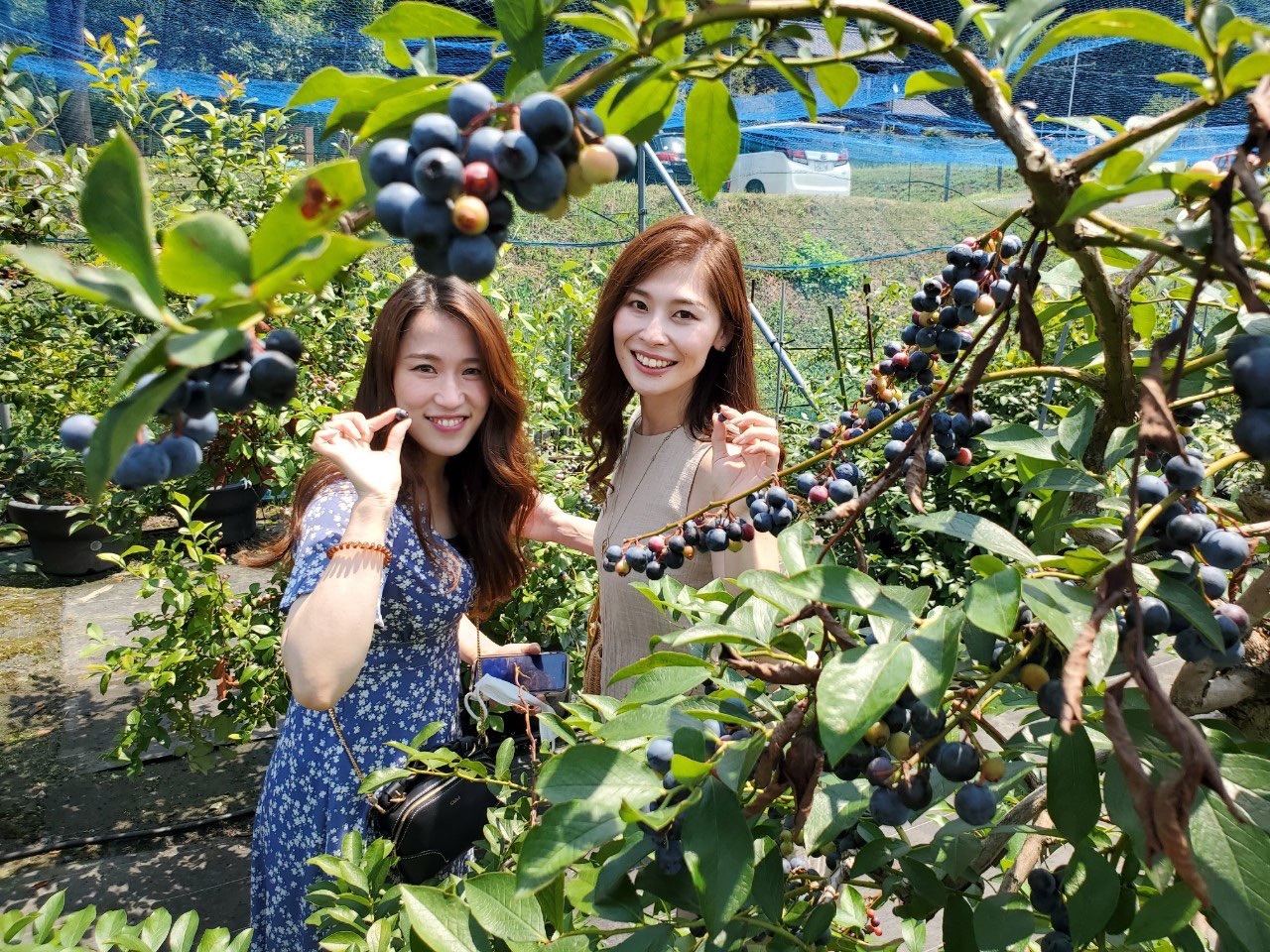
2025 blueberry picking period

June 1 (Sun) – August 17(Sun)
Closed: Thursdays
Open temporarily on August 14.
Opening hours: 09:00 – 16:30
Unlimited time, all-you-can-eat
(A 90 or 120-minute time limit may be imposed on busy weekends)
Price: Free admission. See below for blueberry picking prices (tax included)
・Middle school students and above: ¥2,900
・Elementary school students: ¥1,500
・Toddlers (4 and above) : ¥1,000
・Take-home rate: ¥700/100g
*PayPay and credit cards are accepted.
Please make a booking in advance.
You may be able to make a booking on the same day, depending on availability. Bookings can be made at any time online.
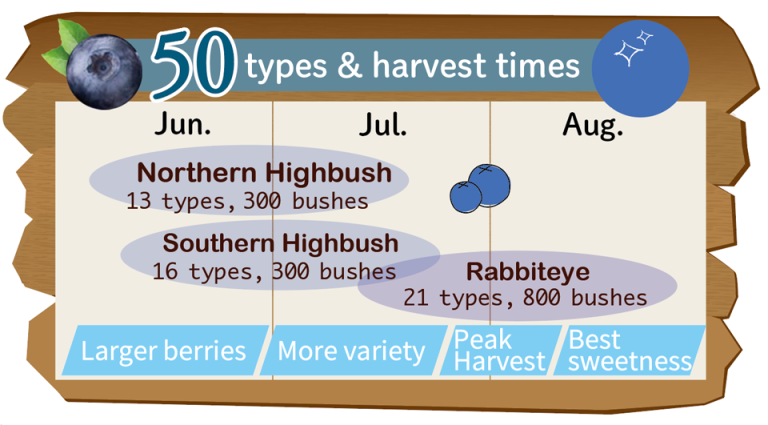
As shown in the diagram above, we cultivate 50 types of blueberries, changing them based on the timing during the season.
Whenever you decide to visit, you will be able to taste and compare 10-20 different types of blueberries.
No matter how often you visit during the same season, each visit will present you with new flavors to discover that will keep you wanting to try more.
Important information (FAQ)

We are open for business as usual on rainy days, however, please make sure to wear appropriate clothing and prepare accordingly for your visit. We lay vinyl tarp on the grounds of the berry field, so visitors do not need to concern themselves with muddying their clothing. If you wish to cancel your booking as a result, please contact us in advance. As there is no cancellation fee, you may move your booking to another day, and we will look forward to seeing you then.
The grounds in the berry field are covered in vinyl tarp, creating an even surface that is easily accessible to strollers and easy to walk on even in high heels and sandals. Summer days at the farm can get incredibly hot, so we recommend bringing a hat and towel to stay cool. In order to protect our blueberries, parasols are not permitted in the berry field. As we use a reduced amount of pesticides (once to twice per year), you may get bitten by an insect. We recommend those who are particularly concerned about insects wear long-sleeved clothing.
There are three restroom facilities on our farm. These include a unisex toilet which is wheelchair friendly and includes a baby changing station, a women’s restroom, a men’s restroom and a wash area.
You do not require an advanced booking to purchase souvenirs or desserts. However, visitors who paid for berry picking will be prioritized during busy hours.
If you wish to take some blueberries home, we recommend bringing your own cooler box. Please note that you cannot bring a cooler box into the blueberry field.
We do not accept large groups of visitors that arrive on buses or minibusses as there is no parking available for large vehicles. However, we can accept large groups that are split into smaller ones.
Please keep your pet on a lead while in the rest space. You are permitted to bring a pet into the blueberry field if you prevent them from consuming the berries, for example, by keeping them inside a pet stroller or carrying them. Please use the designated areas if you enter the cafe with your pet, and make sure that your pet does not stand on the chairs. Groups with multiple pets are not permitted.
Smoking is prohibited. If you wish to smoke, please leave the premises. Smoking is permitted in the parking lot. Alcohol consumption is strictly prohibited on our premises.
Our farm is stroller-friendly. Please contact us in advance if you or someone accompanying you is a wheelchair user as there are stairs on our premises.
Unfortunately, we do not have any facilities for breastfeeding. We recommend using your own car.
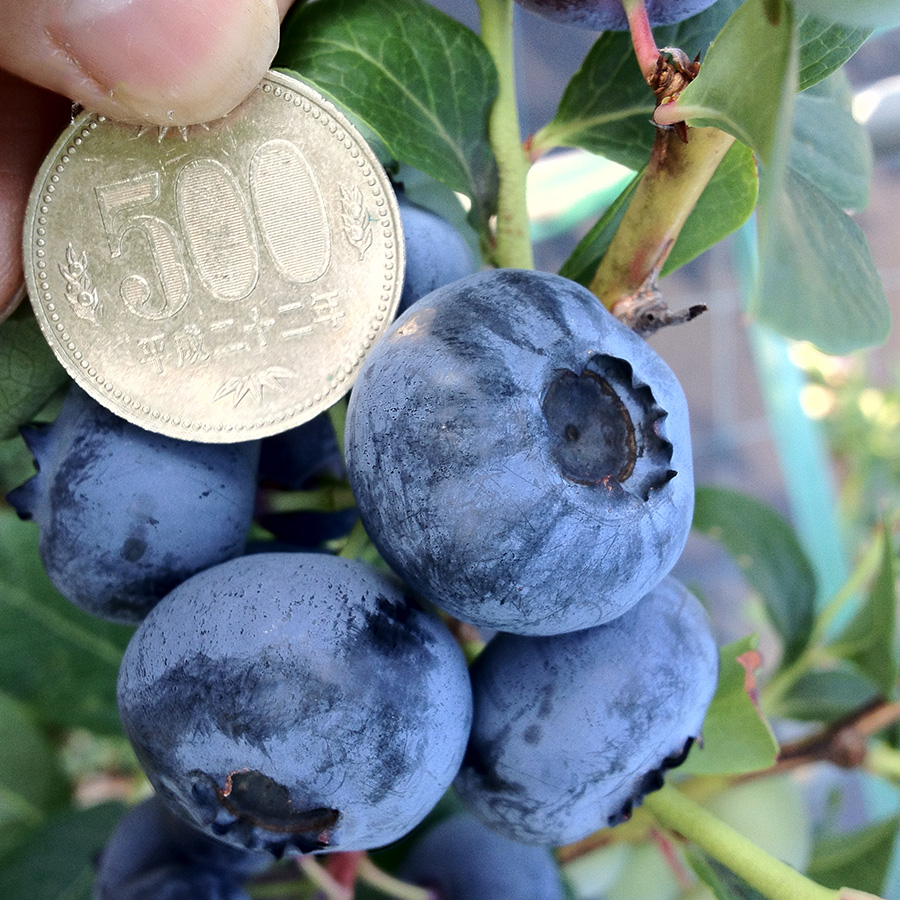
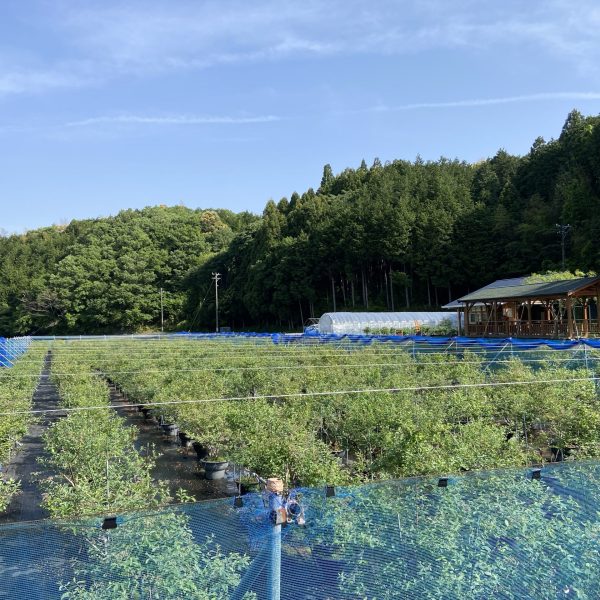
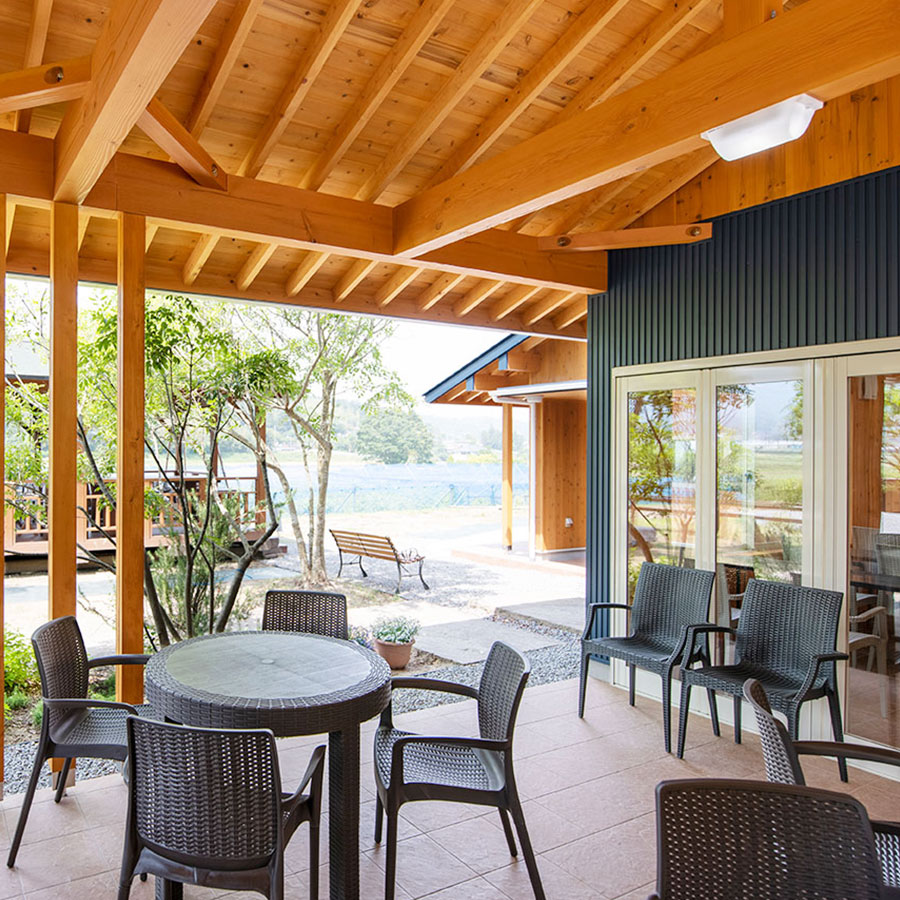
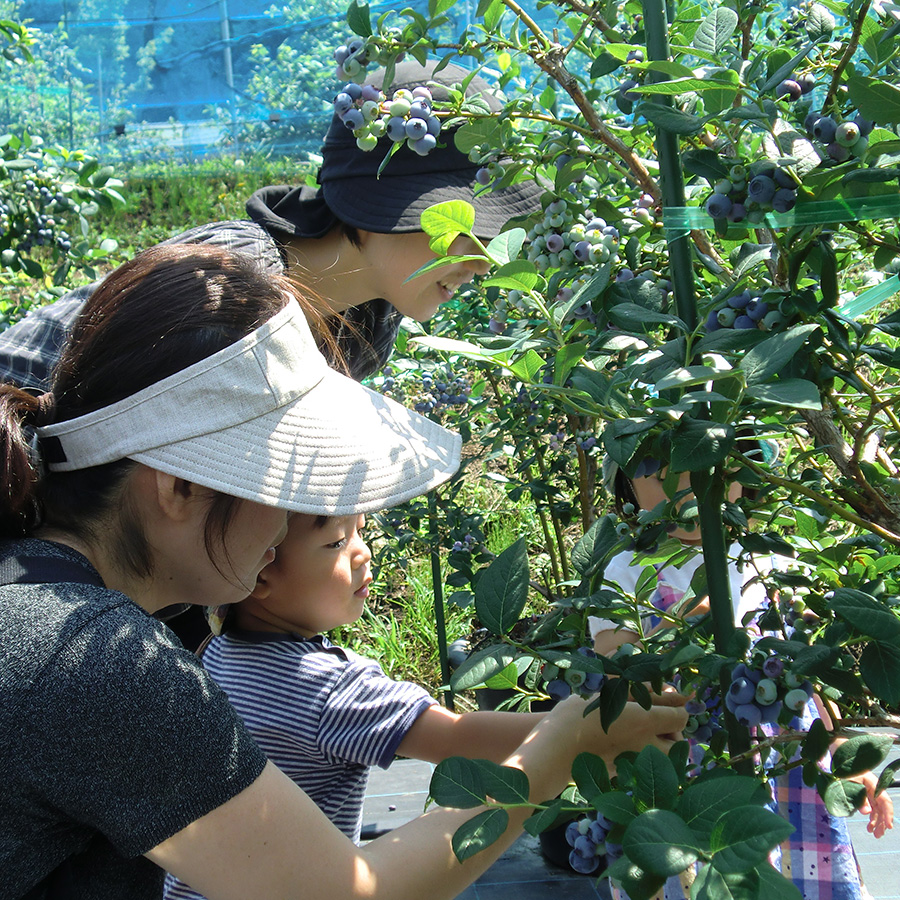

| Size | 5000m2 , 50 species of blueberries, 1,500 blueberry bushes. |
|---|---|
| Parking lot | 1500m2 , 40 spaces |
| Rest Space | 1500m2 log house, indoor seating and terrace seating (70 seats), air conditioned area available. Includes restrooms (1 women’s, 1 men’s and 1 multipurpose), wash area, baby changing station, mist showers. |
| Other | Blueberry picking baskets (free), Ice buckets (charge applies), Rain gear (free) |
| Cafe | Blueberry parfait, gelato, pizza and more limited-time desserts |
| Welcoming Visitors | We welcome visitors to our farm group by group. We are looking forward to introducing you to our berry fields. |

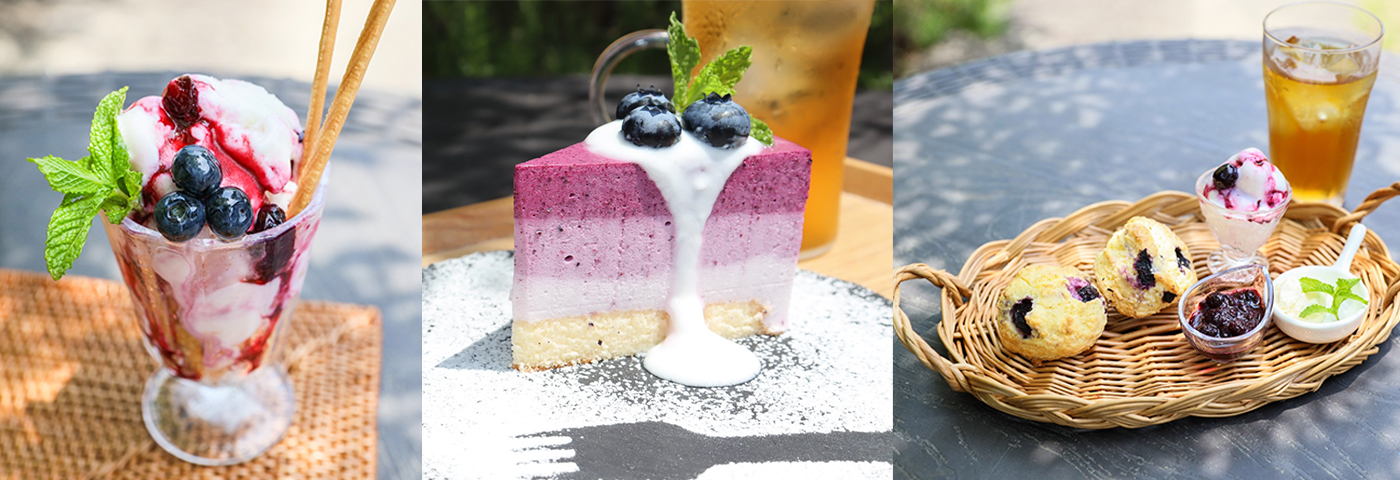

A fruit bush of the Ericaceae family.
Wild blueberries grow in regions ranging from tropical mountain ranges to temperate regions, and even the subarctics. A number of wild species are cultivated from the north eastern regions of America all the way to southern Florida.
The demand for blueberries is gradually increasing in Japan, although the demand and supply are considerably lower compared to North America and Europe, where they are commonly consumed.
Although many may think that blueberries are best enjoyed as a jam, they are just as delicious when picked ripe and enjoyed directly as a fruit. Our farm aims to offer visitors the experience of delicious blueberries fresh from the bush.
Blueberries are known to be delicate and difficult to cultivate. Garden centers may advertise their blueberry bushes as being easy to look after. Unfortunately, the reality is very different.
It is known that blueberries flourish when the soil pH level is maintained at 4.5-5.2 where a neutral pH is 7. However, when growing blueberries, proper drainage of the soil is more important than the pH level and is even considered the most important factor in the cultivation process.
Rice cultivation has played a significant role in Japanese agriculture for centuries. Unfortunately, there are not many areas where soil drainage is good. Soil drainage is particularly bad in the western regions of Japan. Loam soil, which is a healthy mix of sand, silt, and clay soil, can be found naturally in some areas of the Kanto region. However, these areas are limited. Some people choose to grow their own blueberries at home, although it is quite rare to see them being grown in larger quantities.
If you are considering growing a blueberry bush in your garden, we recommend using a plant pot as this makes it easier for the soil to drain.
We recommend planting the seeds in peat moss, however, as previously mentioned, soil drainage is the most important factor to consider when growing blueberries. When growing blueberries in Japan, we recommend a mix of peat moss with either Akadama or Kanuma soil for good drainage.
When it comes to choosing a fertilizer for your blueberries, unlike other crops, blueberries prefer ammonium sulfate fertilizers for their source of nitrogen over nitrate-containing fertilizers. When purchasing a fertilizer, we recommend purchasing a blueberry-specific one from a garden center or such.
At our farm, we utilize a hydroponic system to create the optimal environment for our blueberries, maximizing production and quality. In our hydroponic system, blueberry seeds are planted in pots rather than directly in the ground, enabling us to create the perfect controlled environment. The bushes are grown in pots to regulate soil drainage. A nutrient and water system administers a special mix of nutrients to the crops and maintains the acidity of the soil automatically. This method of horticulture yields a considerably larger quantity of blueberries at 2-3 times the speed of traditional cultivation. The blueberries we produce are sweet, large and full of flavor.
Good for vision
Improve vasodilation, strengthen capillaries
Contain a number of anti-cancer properties, reduce inflammation
Contain antioxidants
Can help protect against some diseases that affect adults, and improve the appearance of skin.
There are around 300-400 varieties of blueberries. We grow a large variety of different types of blueberries every year. Below is a rough summary of our three main types.
| Northern Highbush | These usually grow in colder regions. They are also the first ever blueberry species to be introduced to Japan. Grown in Nagano and the northern areas of the Kanto region, they’re known for their scent, and their perfect balance of flavor, sweetness and tartness. There are limited ways to cultivate them, making them less suitable for growing at home. If you are considering growing them at home, we recommend planting them in a pot. |
|---|---|
| Southern Highbush | Thriving in warmer environments, the Southern Highbush tends to be cultivated in the western areas of the Kanto region closer to the Pacific, and regions of west Japan. This is a relatively new species to Japan that grows in the warmer northern regions. Enjoy its delicious flavor right here on our farm. Out of the three regular varieties we grow on our farm, the Southern Highbush makes the most frequent appearance year after year. However, it is also the most difficult to grow out of our three varieties as its methods of cultivation are very limited. This means it is not easy to grow at home. If you want to grow your own blueberries at home in Japan, we recommend choosing a type that is easier to grow. |
| Rabbiteye | Like the southern highbush species, rabbiteye blueberries generally grow in warmer environments. In comparison to highbush blueberries, rabbiteye blueberry bushes are more adaptable to different soils and have a higher tolerance to heat and drought, making them easier to grow. They’re also sweeter than highbush blueberries. As they are relatively easy to grow, they are suitable for growing at home in Japan. Blueberries are seldom grown in Japan, let alone in gardens. Rabbiteye is the most common variety grown in Japan. Despite being considerably easier to care for, we still recommend growing them in a pot to help with drainage. However, planting them directly in the earth is also ok if you are mindful of soil drainage. |
“Change your life. Pursue your dream job.”
This inspirational thought led to the birth of Blueberry Farm Okazaki.
The day farm owner Shigeki Kuroyanagi took the leap to turn his hobby into a job was an incredible turning point in his life and a decision that gave him a sense of self-fulfillment.
“We only live life once. I don’t want to spend it tied to my company. I want to live life in my own way.” – Words of the 45-year-old farm owner Shigeki Kuroyanagi, who once worked in a managerial position at the global automotive components manufacturer “DENSO”. One day, he decided to take the leap, pursuing his ideal career in farming. Having successfully turned his hobby into his job, he felt he was finally able to express his true self.
We’re aiming to be Japan’s very own blueberry paradise. As a fruit that was introduced after WWII, blueberries are relatively new to the country. It is rare to find a blueberry farm in Japan that produces authentic blueberries. As the flagship farm representing approximately 100 blueberry farms across Japan, we’re aiming to become a calm and relaxing getaway for our visitors—a blueberry-filled paradise.
Even visitors from far away can reach our farm in a considerably shorter time due to our convenient location.
Easy access due to its location in central Mikawa (Ozaki city, Aichi Prefecture)
Our farm can be reached within 15 minutes from Okazaki IC and Otowa Gamagori IC via the Tomei Expressway and Okazaki-higashi on the Shin Tomei Expressway, meaning that it can be reached within one hour from the east and western areas of Aichi prefecture, locally referred to as Mikawa and Owari. Its convenient location makes it the perfect day trip for visitors from areas of the Tokai region including Shizuoka, Gifu and Mie, and even the Kanto, Kansai, Hokuriku and Shinshu regions.
Our farm can be reached within 10 mins from Okazaki IC and 15 mins from Otowa Gamagori IC on the Tomei Expressway, and 12 mins from Okazaki-higashi on the Shin Tomei Expressway. This convenient access enables visitors from far to arrive in a short time for the perfect day trip. For more information on our location, please check the access map.
Meitetsu line: Get off at Miai station and call a taxi. The closest station is Fujikawa station (Meitetsu Nagoya Main Line), which is 1.8km away (30 min walk). As the farm is open during hot summer months, we do not recommend walking if you are unable to bear the heat. A taxi from Miai station costs approximately ¥1,500. The Meitetsu Bus service is also available from Miai station, however, it only makes 3-4 return trips to and from our location during business hours. Please consider making one trip to or from the farm via bus and the other via taxi. Stop: 8 minutes walk from Meitetsu Bus Kuwagai Jutakumae.
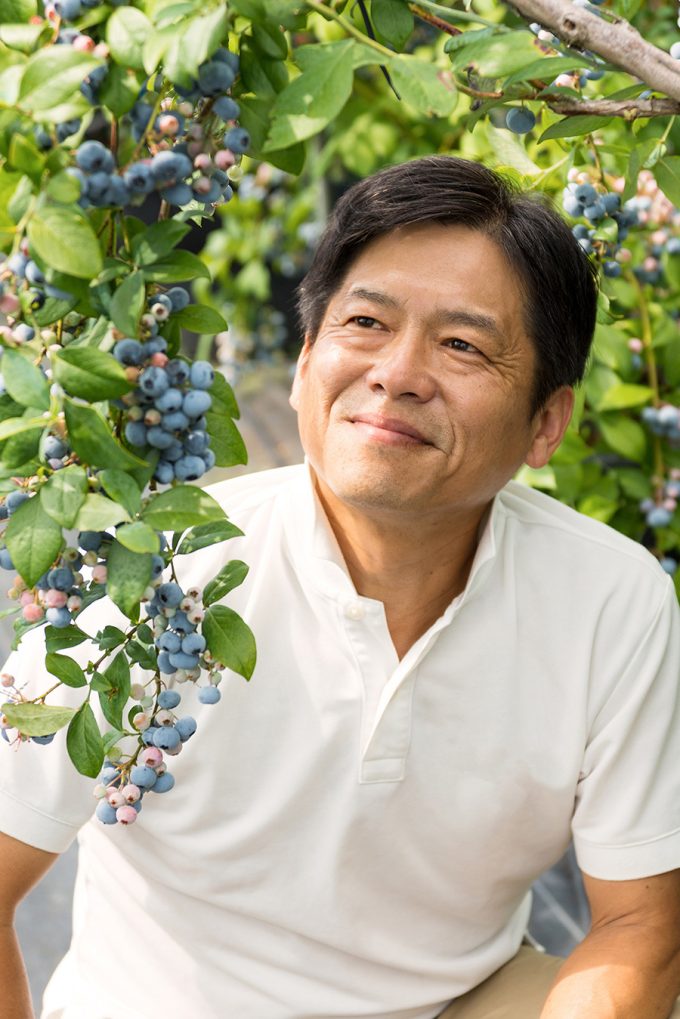
SHIGEKI KUROYANAGI
畔柳 茂樹
Farm owner and founder. Kuroyanagi was born in Okazaki, Aichi prefecture and graduated from Waseda University (Philosophy, Politics, and Economics).
He then went on to join global automotive components manufacturer DENSO, becoming a planning division manager at the age of 40. Eventually, he started to question whether or not this was the life he wanted. His passion for farming soon materialized and he took the leap in 2007 at the age of 45, opening Blueberry Farm Okazaki.
Once the farm was up and running, he used the skills he gained from his experiences as a manager at DENSO to set up an automatic cultivation system and launch a website to attract customers online. With over 10,000 visitors in just one summer, the farm has now become a tourist destination that represents the region. Although the farm is open to the public for just 60 days a year, he earns even more money than he did when he was a manager.
In recent years, he was involved in local restoration efforts to open a berry-picking farm in Kesennuma, Miyagi to restore the land after a natural disaster. In June 2017, he released his first book “Saikyo no Nokigyo!” (The best way to start your own farming business). His sensational book got 9 editions and sold over 20,000 copies. The book also sold a combined total of 29,000 copies in China and Thailand. Furthermore, he was featured in Nomura Research Institute’s NRI Public Management Review January 2018 issue where he shared his advanced farming methods. In November of that same year, he was invited to speak at a conference hosted by the Taiwan-Japan Alliance of Local Revitalization and Social Practice.
Every autumn, he shares his farming knowledge at “Seiko suru Blueberry Noen Koza”, a popular course to which over 1700 people attend. There are currently approximately 100 blueberry farms countrywide that were modeled from his farm (Aug 2022) and are in operation or are preparing to open. This number is predicted to continue increasing. His career has garnered much attention, and he has been interviewed over 170 times.